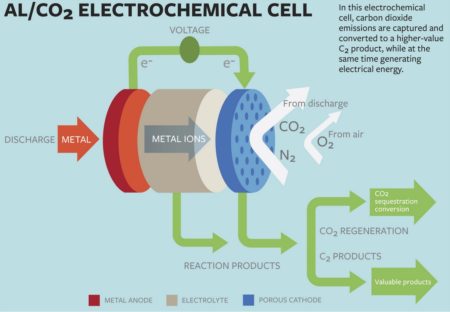Aug
9
CO2 Sequestration Can Work and Salvage Some Energy Too
August 9, 2016 | 3 Comments
Cornell’s press release states, “the human race will always leave its carbon footprint on the Earth, it must continue to find ways to lessen the impact of its fossil fuel consumption.” A welcome perspective without hysteria.
“Carbon capture” technologies – chemically trapping carbon dioxide before it is released into the atmosphere – is one approach. In a recent study, Cornell University researchers disclose a novel method for capturing the greenhouse gas and converting it to a useful product – while producing electrical energy.

This graphic explains novel method for capturing the greenhouse gas and converting it to a useful product — while producing electrical energy.
Image Credit: Cornell University. Click image for the largest view.
Lynden Archer, the James A. Friend Family Distinguished Professor of Engineering, and doctoral student Wajdi Al Sadat have developed an oxygen-assisted aluminum/carbon dioxide power cell that uses electrochemical reactions to both sequester the carbon dioxide and produce electricity.
The group’s proposed cell would use aluminum as the anode and mixed streams of carbon dioxide and oxygen as the active ingredients of the cathode. The electrochemical reactions between the anode and the cathode would sequester the carbon dioxide into carbon-rich compounds while also producing electricity and a valuable oxalate as a byproduct.
In most current carbon-capture models, the carbon is captured in fluids or solids, which are then heated or depressurized to release the carbon dioxide. The concentrated gas must then be compressed and transported to industries able to reuse it, or sequestered underground. The findings in the study represent a possible paradigm shift, Archer said.
“The fact that we’ve designed a carbon capture technology that also generates electricity is, in and of itself, important,” he said. “One of the roadblocks to adopting current carbon dioxide capture technology in electric power plants is that the regeneration of the fluids used for capturing carbon dioxide utilize as much as 25 percent of the energy output of the plant. This seriously limits commercial viability of such technology. Additionally, the captured carbon dioxide must be transported to sites where it can be sequestered or reused, which requires new infrastructure.”
The group reported that their electrochemical cell generated 13 ampere hours per gram of porous carbon (as the cathode) at a discharge potential of around 1.4 volts. The energy produced by the cell is comparable to that produced by the highest energy-density battery systems.
Another key aspect of their findings, Archer says, is in the generation of superoxide intermediates, which are formed when the dioxide is reduced at the cathode. The superoxide reacts with the normally inert carbon dioxide, forming a carbon-carbon oxalate that is widely used in many industries, including pharmaceutical, fiber and metal smelting.
“A process able to convert carbon dioxide into a more reactive molecule such as an oxalate that contains two carbons opens up a cascade of reaction processes that can be used to synthesize a variety of products,” Archer said, noting that the configuration of the electrochemical cell will be dependent on the product one chooses to make from the oxalate.
Al Sadat, who worked on onboard carbon capture vehicles at Saudi Aramco, said this technology in not limited to power-plant applications. “It fits really well with onboard capture in vehicles,” he said, “especially if you think of an internal combustion engine and an auxiliary system that relies on electrical power.”
He said aluminum is the perfect anode for this cell, as it is plentiful, safer than other high-energy density metals and lower in cost than other potential materials (lithium, sodium) while having comparable energy density to lithium. He added that many aluminum plants are already incorporating some sort of power-generation facility into their operations, so this technology could assist in both power generation and reducing carbon emissions.
A current drawback of this technology is that the electrolyte – the liquid connecting the anode to the cathode – is extremely sensitive to water. Ongoing work is addressing the performance of electrochemical systems and the use of electrolytes that are less water-sensitive.
This is something way beyond the breakthrough description, it could very well be a revolution in how we think of carbon based fuels and their cycling within the planetary carbon cycle. The plus of reusing the carbon and oxygen atom over and over again while at each cycling harvesting some electrical current poses a very different situation on net carbon output to the atmosphere.
But even more significant is the inevitable reduction in the fossil fuel demand, at least until the world energy demand accelerates in light of the available energy.
Its one of those wonderful “More, Better, Cheaper” things that progress requires. Congratulation to the Cornell team. Extremely useful work.
But. This tech will run squarely into the U.S. Federal regulatory thicket that will smoother this unmercifully. The current administration has made its business to destroy the coal industry and is well on its way to getting the horrible job done. Can’t imagine the Feds are going to say, “Ah, well. Seems we jumped the gun on killing king coal.” Government doesn’t respect itself or the citizens to ever do anything that responsible. Virtually every time these opportunities come up the government’s mistakes are covered up with even more mistakes.
Our intrepid scientists may think the getting the water sensitivity out is their biggest problem. Its only a challenge. Its the regulatory framework in front of them that is a huge problem.
Comments
3 Comments so far


why bother, CO2 is not a pollutant and is not warming the planet … a waste of money
It is a pity the author cannot refrain from injecting his own political opinions, spoiling an otherwise excellent article with pointless speculation.
Umm, sorry it disappoints you. Not political opinion, its real world political consequence experience.